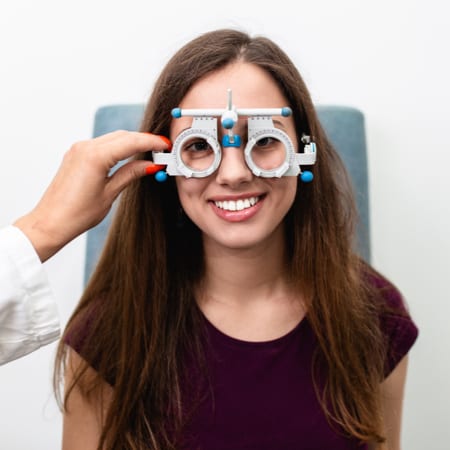The Connection Between Diabetes & Vision
We understand the intricate connection between diabetes and vision and are dedicated to providing comprehensive diabetic eye care using modern diagnostic technology.
Our commitment is to detect and treat diabetes-related vision issues early, preserving your long-term visual health. Book an appointment with us online today.

What to Expect During Your Diabetic Eye Exam
During your diabetic eye examination, our experienced optometrists use modern tools, including fundus photography and optical coherence tomography angiography (OCTA), to assess your vision. These technologies enable a close examination of your retina, allowing for early detection and proactive treatment.


How Diabetes Can Affect Your Vision
Diabetes elevates the risk of developing serious conditions that may impact vision if left untreated, including:
Diabetic retinopathy, a primary concern, and glaucoma can exhibit no symptoms until advanced stages, emphasizing the importance of regular comprehensive eye exams. Whether you have type 1 or type 2 diabetes, we recommend annual eye exams as an integral part of your routine healthcare.
A Closer Look at Diabetic Retinopathy
Diabetic retinopathy stems from elevated blood sugar levels, causing damage to the retina’s blood vessels. Early stages may show no symptoms, but signs can include:
- Seeing spots or floaters
- Blurred vision
- Difficulty seeing at night
Regular dilated eye exams are crucial for monitoring changes in vision and recommending timely treatment.
Our Diagnostic Technology
In our pursuit of comprehensive eye care, Woodstock Vision Care employs modern diagnostic technology, including optical coherence tomography (OCT) and fundus photography.
With OCTA, your eye doctor can capture highly detailed images of the retina, allowing for early detection and monitoring of diabetic retinopathy. This noninvasive imaging test helps track changes in the blood vessels, identify potential issues, and enable timely treatment to protect your vision.
Fundus photography captures a comprehensive view of your retina in a single image, helping with early detection of potential issues. This modern technology aligns with our proactive diabetic eye care approach, prioritizing your long-term visual health.
Diabetic Eye Exams Backed by Technology
Our diabetic eye exams combine knowledge with innovative diagnostic technology to obtain a clear understanding of your visual situation. We’re committed to helping you maintain healthy, long-term vision.
Book online to schedule an appointment and take proactive steps toward addressing diabetes-related vision concerns.















